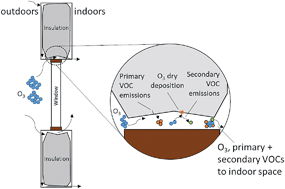Emerging investigator series: primary emissions, ozone reactivity, and byproduct emissions from building insulation materials†
Abstract
Building insulation materials can affect indoor air by (i) releasing primary volatile organic compounds (VOCs) from building enclosure cavities to the interior space, (ii) mitigating exposure to outdoor pollutants through reactive deposition (of oxidants, e.g., ozone) or filtration (of particles) in infiltration air, and (iii) generating secondary VOCs and other gas-phase byproducts resulting from oxidant reactions. This study reports primary VOC emission fluxes, ozone (O3) reaction probabilities (γ), and O3 reaction byproduct yields for eight common, commercially available insulation materials. Fluxes of primary VOCs from the materials, measured in a continuous flow reactor using proton transfer reaction-time of flight-mass spectrometry, ranged from 3 (polystyrene with thermal backing) to 61 (cellulose) μmol m−2 h−1 (with total VOC mass emission rates estimated to be between ∼0.3 and ∼3.3 mg m−2 h−1). Major primary VOC fluxes from cellulose were tentatively identified as compounds likely associated with cellulose chemical and thermal decomposition products. Ozone-material γ ranged from ∼1 × 10−6 to ∼30 × 10−6. Polystyrene with thermal backing and polyisocyanurate had the lowest γ, while cellulose and fiberglass had the highest. In the presence of O3, total observed volatile byproduct yields ranged from 0.25 (polystyrene) to 0.85 (recycled denim) moles of VOCs produced per mole of O3 consumed, or equivalent to secondary fluxes that range from 0.71 (polystyrene) to 10 (recycled denim) μmol m−2 h−1. Major emitted products in the presence of O3 were generally different from primary emissions and were characterized by yields of aldehydes and acetone. This work provides new data that can be used to evaluate and eventually model the impact of “hidden” materials (i.e., those present inside wall cavities) on indoor air quality. The data may also guide building enclosure material selection, especially for buildings in areas of high outdoor O3.

- This article is part of the themed collections: Emerging Investigator Series, Indoor Air: Sources, Chemistry and Health Effects and ESPI Cover Art 2019


 Please wait while we load your content...
Please wait while we load your content...